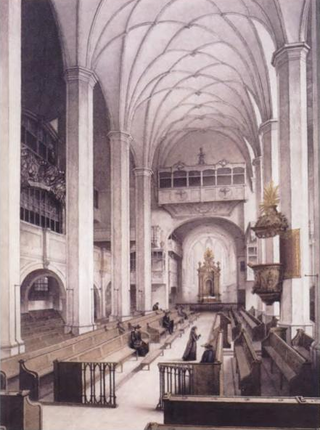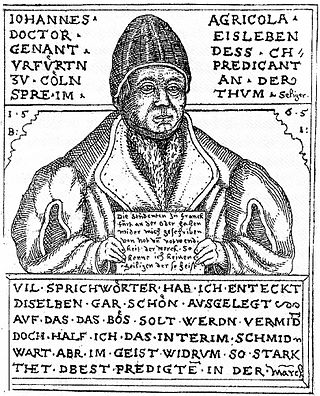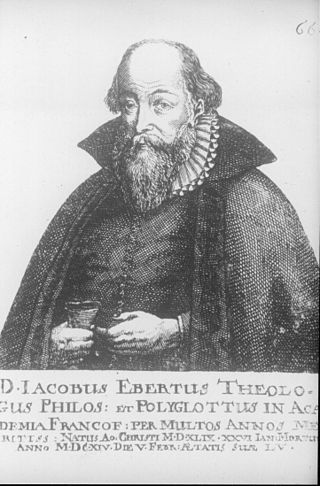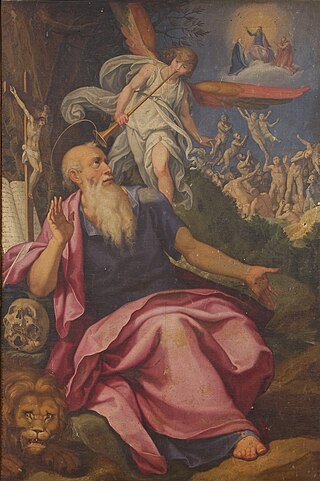Related Research Articles
Throughout his life as a musician, Johann Sebastian Bach composed cantatas for both secular and sacred use. His church cantatas are cantatas which he composed for use in the Lutheran church, mainly intended for the occasions of the liturgical year.

Sechs Chorale von verschiedener Art: auf einer Orgel mit 2 Clavieren und Pedal vorzuspielen, commonly known as the Schübler Chorales, BWV 645–650, is a set of chorale preludes composed by Johann Sebastian Bach. Johann Georg Schübler, after whom the collection came to be named, published it in 1747 or before August 1748, in Zella St. Blasii. At least five preludes of the compilation are transcribed from movements in Bach's church cantatas, mostly chorale cantatas he had composed around two decades earlier.

"Ach Gott, wie manches Herzeleid" is a German hymn in 18 stanzas attributed to Martin Moller (1587). It is often catalogued as a paraphrase of the Latin "Jesu dulcis memoria", a medieval hymn attributed to Bernard of Clairvaux, but only a few lines refer directly to this song. Hymn tunes were composed for the hymn, and it is also often sung to a tune composed for "Herr Jesu Christ, meins Lebens Licht". The anonymous hymn tune of "Herr Jesu Christ, meins Lebens Licht" first appeared in Wolflein Lochamer's Lochamer-Liederbuch, printed in Nürnberg around 1455. In Leipzig in the 1720s, Johann Sebastian Bach composed settings of Lochamer's hymn based on four of his church cantatas and a sacred motet.

Ach Gott, wie manches Herzeleid, BWV 58, is a church cantata by Johann Sebastian Bach. He composed the dialogue cantata in Leipzig for the Sunday after New Year's Day.

Johann Sebastian Bach composed the church cantata Allein zu dir, Herr Jesu Christ, BWV 33, in Leipzig in 1724 for the thirteenth Sunday after Trinity and first performed it on 3 September 1724. The chorale cantata is based on the hymn "Allein zu dir, Herr Jesu Christ" by Konrad Hubert (1540).
"Wär Gott nicht mit uns diese Zeit" is a Lutheran hymn, with words written by Martin Luther based on the Psalm 124. The hymn in three stanzas of seven lines each was first published in 1524. It was translated to English and has appeared in 20 hymnals. The hymn formed the base of several compositions, including chorale cantatas by Buxtehude and Bach.

"Aus tiefer Not schrei ich zu dir", originally "Aus tieffer not schrey ich zu dir", later also "Aus tiefer Noth schrei' ich zu dir", is a Lutheran hymn of 1524, with words written by Martin Luther as a paraphrase of Psalm 130. It was first published in 1524 as one of eight songs in the first Lutheran hymnal, the Achtliederbuch, which contained four songs by Luther, three by Paul Speratus, and one by Justus Jonas, and also appeared the same year in the Erfurt Enchiridion. It is part of many hymnals, also in translations. The text inspired vocal and organ music from the Renaissance to contemporary, including composers such as Johann Sebastian Bach, who based a chorale cantata on it, Felix Mendelssohn and Max Reger.

Johann Sebastian Bach composed the church cantata Ich ruf zu dir, Herr Jesu Christ, BWV 177. He wrote the chorale cantata in Leipzig for the fourth Sunday after Trinity and first performed it on 6 July 1732. The cantata text is formed by the unchanged five stanzas of Johann Agricola's hymn.

Johann Sebastian Bach composed the church cantata Herr Christ, der einge Gottessohn, BWV 96, in Leipzig for the 18th Sunday after Trinity and first performed it on 8 October 1724. The chorale cantata, part of Bach's second annual cycle, is based on the hymn in five stanzas "Herr Christ, der einig Gotts Sohn" by Elisabeth Cruciger, published in Eyn geystlich Gesangk Buchleyn in 1524.

Johann Sebastian Bach composed the church cantata Du Friedefürst, Herr Jesu Christ, BWV 116, in Leipzig for the 25th Sunday after Trinity. He led the first performance on 26 November 1724, concluding the liturgical year of 1724.

"Gelobet seist du, Jesu Christ" is a Lutheran hymn, written by Martin Luther in 1524. It was first published in 1524 in the Eyn geystlich Gesangk Buchleyn. For centuries the chorale has been the prominent hymn (Hauptlied) for Christmas Day in German speaking Lutheranism, but has also been used in different translations internationally. It has appeared in hymnals of various denominations including the Catholic Church.

Johann Sebastian Bach composed the church cantata Nimm von uns, Herr, du treuer Gott, BWV 101 in Leipzig for the tenth Sunday after Trinity and first performed it on 13 August 1724. The chorale cantata is based on the hymn by Martin Moller (1584).

Johann Sebastian Bach composed the church cantata Herr Jesu Christ, du höchstes Gut, BWV 113 in Leipzig for the eleventh Sunday after Trinity and first performed it on 20 August 1724. The chorale cantata is based on the hymn "Herr Jesu Christ, du höchstes Gut" by Bartholomäus Ringwaldt (1588).

Johann Sebastian Bach composed the church cantata Schmücke dich, o liebe Seele, BWV 180, in Leipzig for the 20th Sunday after Trinity and first performed it on 22 October 1724.

Herr Jesu Christ, wahr' Mensch und Gott, BWV 127, is a cantata by Johann Sebastian Bach for use in a Lutheran service. He composed the chorale cantata in 1725 in Leipzig for the Sunday Estomihi, the Sunday before Lent. It is based on Paul Eber's 1582 hymn in eight stanzas "Herr Jesu Christ, wahr Mensch und Gott". Bach first performed it on 11 February 1725.

"Herr Christ, der einig Gotts Sohn" is a Lutheran hymn by Elisabeth Cruciger. Printed in 1524 in the Erfurt Enchiridion, together with 18 hymns by Martin Luther, it is one of the oldest Lutheran hymns. The text combines Lutheran teaching with medieval mysticism. It has been the basis of musical settings such as Bach's chorale cantata Herr Christ, der einge Gottessohn, BWV 96.

"Gott sei gelobet und gebenedeiet" is a Lutheran hymn of 1524 with words written by Martin Luther who used an older first stanza and melody. It is a song of thanks after communion. Luther's version in three stanzas was printed in the Erfurt Enchiridion of 1524 and in Johann Walter's choral hymnal Eyn geystlich Gesangk Buchleyn the same year. Today, the song appears in German hymnals, including both the Protestant Evangelisches Gesangbuch, and in a different version in the Catholic Gotteslob.
Johann Sebastian Bach's chorale cantata cycle is the year-cycle of church cantatas he started composing in Leipzig from the first Sunday after Trinity in 1724. It followed the cantata cycle he had composed from his appointment as Thomaskantor after Trinity in 1723.
"Herr Jesu Christ, du höchstes Gut" is the beginning of two Lutheran hymns. One is a penitential hymn, written in 1588 by Bartholomäus Ringwaldt, who possibly also created the melody. The other is an anonymous communion hymn, probably based on the former, which appeared first in 1713. Johann Sebastian Bach's used the penitential hymn several times, including the chorale cantata Herr Jesu Christ, du höchstes Gut, BWV 113, based on the hymn.
References
- ↑ Sadie, Stanley, ed. (2001). The New Grove Dictionary of Music and Musicians . Oxford University Press. pp. II 331–5, V 26–7, 746, XIV 511–4. ISBN 978-0-19-517067-2.
- ↑ Leahy, Anne; Leaver, Robin A. (2011). J. S. Bach's "Leipzig" Chorale Preludes: Music, Text, Theology. Scarecrow Press. p. 79. ISBN 978-0-8108-8181-5.
- 1 2 Hofmann, Klaus (2002). "O Ewigkeit, du Donnerwort, BWV 20 / O eternity, thou thunderous word" (PDF). bach-cantatas.com. p. 5. Retrieved 5 June 2012.
- ↑ Christoph Wolff (1991). Bach: Essays on his Life and Music. Harvard University Press. ISBN 978-0-674-05926-9 . Retrieved 21 June 2011.
- ↑ John Eliot Gardiner (2004). "Cantatas for the First Sunday after Trinity / St Giles Cripplegate, London" (PDF). bach-cantatas.com. p. 2. Retrieved 5 June 2012.
- ↑ Dürr, Alfred (1971). Die Kantaten von Johann Sebastian Bach (in German). Vol. 1. Bärenreiter-Verlag. OCLC 523584.
- 1 2 Günther Zedler. Die Kantaten von Johann Sebastian Bach: Eine Einführung in die Werkgattung. Books on Demand, 2011. ISBN 9783842357259, p. 32–34
- ↑ Hewett, Ivan (2013). "Bach Marathon, Albert Hall, Review". The Telegraph . Retrieved 4 May 2015.
- 1 2 Alfred Dörffel. Bach-Gesellschaft Ausgabe Volume 27: Thematisches Verzeichniss der Kirchencantaten No. 1–120 . Breitkopf & Härtel, 1878. Introduction, pp. V–IX
- ↑ Philippe (and Gérard) Zwang. Guide pratique des cantates de Bach. Paris, 1982. ISBN 2-221-00749-2. See Johann Sebastian Bach: Correspondance Catalogues Zwang — Schmeider at www
.musiqueorguequebec .ca - ↑ "Choralkantate" [ permanent dead link ] at www
.bach-digital .de - 1 2 Chorale Melodies used in Bach's Vocal Works: Was mein Gott will, das g'scheh allzeit at www
.bach-cantatas .com - 1 2 Louis Bourgeois (editor; composer). Pseaumes Octante Trois de David . Geneva, 1551.
- ↑ Julian Mincham (2010). "Chapter 5 BWV 135 Ach Herr, mich armen Sünder". jsbachcantatas.com. Archived from the original on 5 December 2011. Retrieved 4 July 2011.
- ↑ Johann Rist (author) and Johann Schop (composer, editor). Johann Risten Himlische Lieder (revised edition). Lüneburg: Johann & Heinrich Stern, 1658, pp. 34–36 (I, No. 6) and 202–208 (III, No. 10)
- ↑ Carl von Winterfeld. Der evangelische Kirchengesang und sein Verhältniss zur Kunst des Tonsatzes. Breitkopf und Härtel, 1843, p. 415
- ↑ Philippe and Gérard Zwang. Guide pratique des cantates de Bach. Second revised and augmented edition. L'Harmattan, 2005. ISBN 9782296426078. pp. 43–44